Abstract
According to the IEA Global Status Report for Buildings and Construction 2019, one of the main industry sectors causing environmental impacts is the construction sector. Hence, construction materials from renewable resources are expected to have a large potential to decrease these impacts. In this study, a Life Cycle Assessment (LCA) was conducted for four different insulation materials from renewable feedstock: insulation made from pasture grass, seaweed, reed, and recycled jute fibres. Additionally, the effects on land use change were evaluated for pasture grass insulation using the LANCA® methodology. To put the LCA results in relation to those of non-renewable resources, a comparison of standardized LCA values for conventional insulation materials is presented. In general, the renewable insulation materials show fewer environmental impacts than their conventional counterparts. In particular, these materials have advantages regarding greenhouse gas emissions and their impact on climate change. Of the analyzed materials, seaweed showed the overall lowest emissions. It can be concluded that insulation materials from non-mineral, non-fossil, and non-wooden resources are still fairly niche in terms of market share, but they have extraordinary potential in decreasing the environmental impacts of construction ventures.
1. Introduction
Energy demand and the related environmental impacts in the use phase of buildings are still of high relevance due to high heating demands [1]. In the case of uninsulated or badly insulated buildings, this can be even more significant. Therefore, thermal insulation is increasingly demanded at the policymaking level in Germany. Considering the Life Cycle Assessment (LCA) of buildings and their use phase, the energy savings outweigh the impacts of insulation materials [2]. However, there still is a high potential for decreasing environmental impacts. In this context, various insulation materials made from renewable raw materials have been added to the market. In addition to their fundamentally necessary high thermal conductivities and heat storage capacities, regenerative insulation materials contribute to the conservation of resources. This is because they store CO2 during their lifetime and afterwards potentially substitute fossil resources. Nevertheless, their share in the German market is still small [3]. According to the “Fachagentur Nachwachsende Rohstoffe e.V.” (FNR), the market share, shown in Figure 1, of renewable insulation materials in Germany is about 9%, and only around 10% of those renewable insulation materials are made from non-wood sources; see [4].
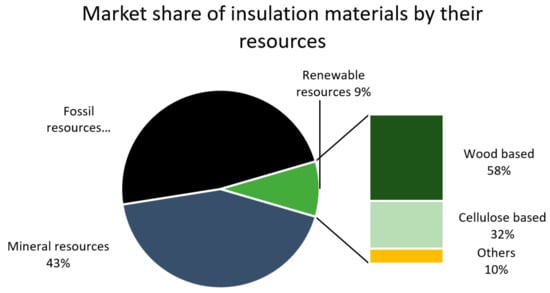
Figure 1.
Market shares of insulation material by raw materials in Germany in 2019; Adapted with permission from FNR, [4].
Since other renewable materials are still niche (see Figure 1), proper environmental analyses of their life cycle potential are scarce. In order to gain insight into the sustainability of these materials and be able to evaluate them in terms of their impact on climate change, an LCA of selected materials is carried out and published in this paper. Insulation materials made from meadow grass, seaweed, reed, and jute fibers are examined in detail. For an insulation material made from meadow grass, a land use change assessment (LANCA®) is additionally conducted.
To give a better overview, the calculated impacts are compared to the environmental impacts of conventional insulation materials made from mineral and fossil sources. These impact values are taken from the German Ökobaudat, a standardized, open access database that contains values for the ecological evaluations of buildings [5].
2. Materials and Methods
In the following, the case study materials and methods applied are laid out and described in detail.
2.1. Case Study Materials
In this study, the environmental impacts of four different kinds of insulation materials made from four different kinds of renewable resources were assessed; the source region of raw material is noted in brackets:
- Meadow grass (Germany);
- Seaweed (Mediterranean Sea);
- Reed (Turkey);
- Recycled jute (Germany).
The insulation material made from reed is harvested and produced in Turkey, while the other case study materials are all produced in Germany. The raw material used for the meadow grass is grown in Germany, while the seaweed is collected on the coastlines of the Mediterranean Sea. The recycled jute is sourced from used cacao and coffee bean bags. As the defibration is carried out upstream and not part of the insulation material production process, it is not included in this study. The point of sale for all materials is Germany. Each insulation material requires specific treatment before production. The respective production systems and the system boundaries applied in the LCA and LANCA® analyses are shown in Figure 2, Figure 3, Figure 4 and Figure 5.
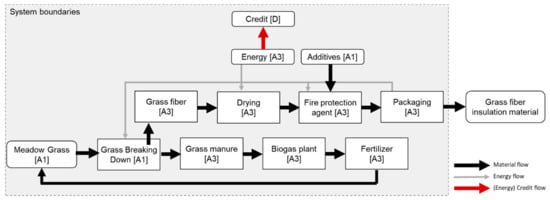
Figure 2.
Production system of the insulation material made from meadow grass.
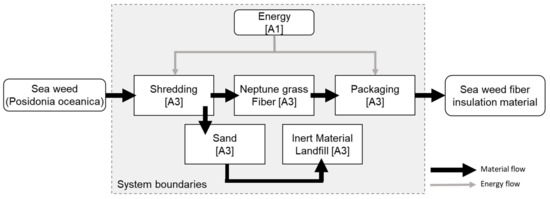
Figure 3.
Production system of the insulation material made from seaweed; striped lining marks the considered system boundaries.

Figure 4.
Production system of the insulation material made from reed.

Figure 5.
Production system of the insulation material made from recycled jute.
In line with EN 15804, a “declared unit” was chosen instead of a “functional unit”. This is due to the fact that a material comparison is performed independent of the functional application of the type of insulation used (internal, external, roof, floor, etc.) The chosen declared unit was 1 kg of insulation material. Accordingly, all impacts were calculated and reported for 1 kg of material to provide a convenient measured value for conversion into a specific application. An insight into the insulation characteristics of the four different materials is given in Table 1.

Table 1.
Construction and insulation characteristics of the study materials.
All the insulation materials show class B2 fire behavior for construction materials according to DIN 4102-1, meaning they are normally flammable [6]. To reach that level of fire protection, fire retardants must be added in the production process of the pasture grass and the jute insulation material. For the materials made from seaweed and reed, no additional chemical treatment is required. Seaweed has natural fire protection from the sea salt. The packed plate structure of the reed stem insulation provides sufficient protection for the B2 level. Further, no mold development has been detected for any of the study materials according to the respective technical datasheets.
2.2. LCA
The LCA was conducted based on the approach laid out in DIN EN ISO 14040 and 14044 [7,8]. Accordingly, the analysis consisted of four phases. The first step was to define a research objective and framework. After the scope had been determined, the Life Cycle Inventory analysis was conducted. In this context, each process step was identified, and the corresponding data were collected. The third phase was the impact assessment (LCIA), in which the emissions were classified and characterized with their respective factors for the selected impact categories. In the case of this study, Global Warming Potential (GWP), Ozone Depletion Potential (ODP), Acidification Potential (AP), Eutrophication Potential (EP), Photochemical Ozone Creation Potential (POCP), abiotic depletion potential for non-fossil resources (ADPE), and abiotic depletion potential for fossil resources (ADPF) were chosen according to the latest CML methodology from the 5th of September 2016 [9,10,11]. For this purpose, a model of the production system including all available material and energy flows was created. The final step included interpreting the results of the impact assessment. In accordance with DIN EN ISO 14040 and 14044, for LCA studies in the construction sector the DIN EN 15804 for sustainable construction, which specifies the general standards, is recommended [12]. This was developed for the preparation of Type III Environmental Product Declarations (EPD) and firmly established for the comparison of building products and structures at the ecological level [13]. The standard EN 15804 divides the product system into specific life stages. For the model created, the focus was placed on the production phase (A1–A3, see Table 1) [12]. This means that the raw material supply, the transport, and the production at the manufacturing site were considered. In addition, the disposal of the product packaging, as well as the disposal of the product itself, or its possibility for reuse as material or fuel (including credits for the generation of energy through incineration), was included in the model. The use phase was not considered due to its high level of individuality caused by the specific application scenario and building type. A detailed overview on the applied life cycle phases and life cycle steps is given in Table 2.

Table 2.
Modules of the life cycle of construction materials structured according to DIN EN ISO 15804 [12].
For the modelling of the production system, version 8.7 ts Professional 2019 of the GaBi software and database was used [14]. For the calculation of the final results, the modelling principals given in the CML 2001 Method were applied [9,10]. This selection was defined in 2017 according to the requirements of the EN 15804 of that year. As there is no updated version of the CML methodology, the results provide the latest state of the selected methodology and represent the time of the data collection. The data were collected in interviews with manufacturers, including respective site visits through questionnaires during the period 1 January 2018 to 31 December 2019, and checked for plausibility as far as possible. Data on energy consumption were partly provided on a product-specific basis. Otherwise, data on total plants or other infrastructure expenditures were extrapolated down to the individual products by mass and/or economic value. The production of 1 kg of insulation material was considered in each case; see above.
2.3. LANCA®
For the land use assessment, the LANCA® method (Land Use Indicator Value Calculation) was applied. Here, land use indicators for “transformation” and “occupation” are provided. “Transformation” addresses the permanent impacts that are caused by the respective land use but occur after the land use period. For the “occupation”, the impacts occur during the time of land use. The calculation scheme can be seen in Figure 6. For the analysis of occupation influences, the soil quality after the regeneration of the area is compared with the quality during land use. For the transformation impacts, on the other hand, the soil quality before the land use under consideration is compared with that after the regeneration of the area [15,16,17].
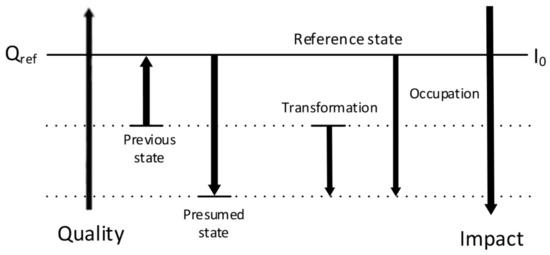
Figure 6.
Schematic representation of transformation and occupation calculation of LANCA® indicators (Adapted with permission from Bos et al., 2016 [16]).
In this study, the LANCA® impact categories assessed were Erosion Resistance (ER), Mechanical Filtration (MF), Physicochemical Filtration (PCF), and Groundwater Rejuvenation (GWN). All impact categories are given in relation to 1 m2 of soil. No LANCA© investigation could be carried out for insulation materials made of seagrass and reed, as aquatic areas are currently not in the design spectrum of the methodology. Since the jute insulation material is made from burden-free secondary material, the influence of land use was not investigated further. The LANCA© study was therefore carried out exclusively for insulation materials made from meadow grass fibers, since most environmental impacts from farming processes relate directly to their local surroundings. Consequently, the analysis of land use change was included for this specific product.
3. Results
In the following, the results of the LCA and LANCA® analyses of the four different insulation materials are displayed and interpreted.
3.1. Insulation Material from Meadow Grass
The insulation material made from meadow grass assessed in this study generally showed low impacts despite the energy demand of the production process. The production system closes the production cycle by using waste from the preceding pulping process in a biogas plant for the creation of electrical and thermal energy. Due to this closed loop, the resources are almost entirely used and the impacts are hereby reduced within the production process. The resulting impacts of the assessed modules are listed in Table 3.

Table 3.
Environmental impacts of 1 kg of insulation material made from meadow grass.
The LANCA® analysis results are shown in Table 4.

Table 4.
Results of the LANCA analysis of the meadow gras insulation material.
The cultivated area of the meadow grass insulation material was extensively managed and there was no crop rotation in the observation period of 10 years. Since the cultivation always remained constant and thus no transformation occurred, the effects of land use also remained constant at the different times of occupation (t1-4). Therefore, only one state of land use tLN is considered. The reference state tref here is a natural, uncultivated pasture in central Germany.
This means a land use change for all impact categories, as shown in Figure 7. Herein, a value of 1 resembles no change, a value > 1 indicates an increase, and <1 indicates a decrease. For the impact category “Erosion Resistance”, which is, by its nature, given in negative values, the indication is other way around: a value > 1 indicates a decrease and a factor < 1 an increase, while a value of 1 means no change.
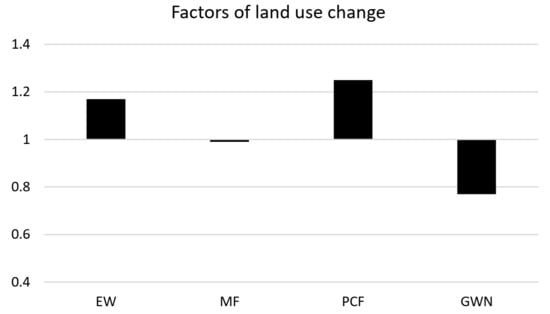
Figure 7.
Land use change factors of the different impact categories of the LANCA analysis of insulation materials from pasture grass (EW = erosion resistance, MF = mechanical filtration, PCF = physico-chemical filtration, and GWN = groundwater rejuvenation).
For the cultivation of pasture grass, an increase in physico-chemical filtration and a decrease in erosion potential and groundwater rejuvenation were determined. For mechanical filtration, no change was determined.
3.2. Insulation Material Made from Seaweed
In Table 5, the environmental impact for the insulation material made from seaweed is noted. Since the seaweed grows uncultivated and is not harvested, as the dead fibers are collected by hand on shore, the production of the raw material is considered burden free. Nevertheless, the incorporation of CO2 into organic matter through photosynthesis is accredited in this assessment to ensure a closed carbon balance, which results in a negative GWP. Similar results are shown for ODP, POCP, ADPE, and ADPF.

Table 5.
Environmental Impacts of 1 kg of insulation material made from seaweed.
3.3. Insulation Material Made from Reed
For the production of the insulation material made from reed, the reed is not cultivated but grows naturally and is harvested in central Turkey. Due to the conversion of CO2 into organic matter through photosynthesis, a negative GWP, meaning the retention of CO2, is calculated. Similar effects are shown for POCP, ADPE and ADPF. For the impact categories ODP, EP and AP are positive impacts, meaning emissions into the environment are calculated as show in Table 6.

Table 6.
Environmental impacts of 1 kg of insulation material made from reed.
3.4. Insulation Material Made from Recycled Jute
The jute fibers used for the production of this insulation material were recycled from old cacao and coffee bean bags. Following the conservative cut-off criteria, their cultivation is considered burden-free in this assessment. As with the insulation materials from reed and seaweed, negative impact values were calculated for the impact categories GWP and POCP. The reasoning here is the burden-free jute and the credits in module D. The results are listed in Table 7.

Table 7.
Environmental Impacts of 1 kg of insulation material made from recycled jute.
4. Discussion
The overall environmental impacts for the assessed insulation materials from renewable resources are very low. Due to credits for energy generation from waste incineration and the effects of biotic production and photosynthesis, some impact categories even reach negative impacts, meaning a sequestration of the respective compounds.
For GWP, the least impacts were shown by the insulation material made from reed. However, even the material made from meadow grass, which showed the highest impacts within this study, had relatively low values of CO2 equivalent. The life cycle phase with the highest impacts in GWP is module C3 waste treatment due to applied waste incineration. However, these impacts are (partly) offset by the credits for energy generation from this waste incineration in module D. The credits are calculated with a negative demand from the German grid mix and thermal energy from natural gas. Therefore, a certain amount of fossil GWP is gained as well. The analysis of fossil GWP showed similar results, with the exception of the insulation material from meadow grass. Since there is a biogas plant integrated in the production system, most of its GWP emissions were of a biogenic nature. In addition, the use of the energy created in said biogas plant avoided the use of the conventional German grid mix and thermal energy from natural gas and hereby reduced some amounts of fossil-based greenhouse gas emissions.
For EP and AP, the most crucial phases are the production of raw material and the production of the material itself (modules A1 and A3). Agricultural processes generally show high impacts in these categories due to nutrient and salt discharge in the field.
The impact categories ODP, ADPE, and ADPF strongly profit from the credits for energy generation from waste incineration in module D. In most cases, the credits in impact equal the impacts from production and low impacts are calculated in these impact categories. The ODP of the materials made from meadow grass, seaweed, and jute even show negative values.
For POCP, all insulation materials show a negative impact, meaning an uptake of C2H4 eq. This derives not only from the credits in module D, but also from the transport processes involved. Here, it should be noted that the POCP of the CML methodology has the peculiarity that NO emissions—in contrast to the other existing impact assessment methods—have a negative characterization factor. The negative factor arises from the fact that the emitted nitrogen monoxide has the characteristic of binding ground-level ozone (NO + O3 → NO2 + O2). This effect is taken into account in the CML characterization method by a negative value of the NO characterization factor. This leads to negative results, especially for transport processes, since the effects of the nitrogen monoxide outweigh the effects of the other emissions caused [9,10]. This can lead to misleading interpretations, which is why the results in this category should be critically questioned, especially when making strategic decisions [18]. In addition, the comparability of the results obtained with the CML method to those of other methods—e.g., ReCiPe [19]—is not given. Therefore, considering these insulation materials as a sink for POCP should be avoided.
In Figure 8, Figure 9, Figure 10, Figure 11, Figure 12, Figure 13 and Figure 14, a comparison is given of the four renewable insulation materials and three conventional insulation materials. Exemplars chosen included the most commonly used materials: a blow-in insulation (mineral wool), a bulk material (XPS), and a foam material (solid PIR foam). All the impacts listed were taken from the Ökobaudat [5].

Figure 8.
Comparison of the GWP of conventional and renewable insulation materials.
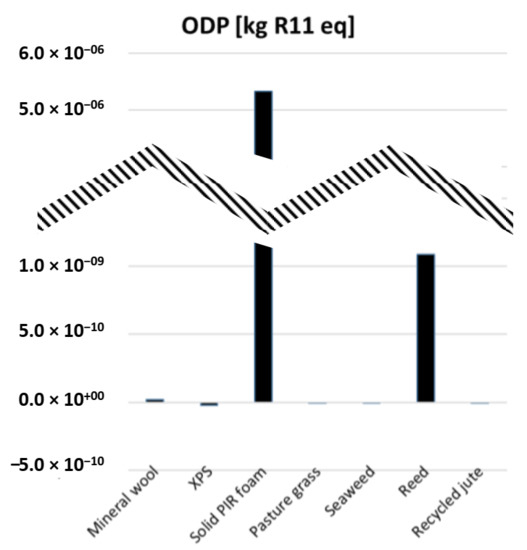
Figure 9.
Comparison of the ODP of conventional and renewable insulation materials.
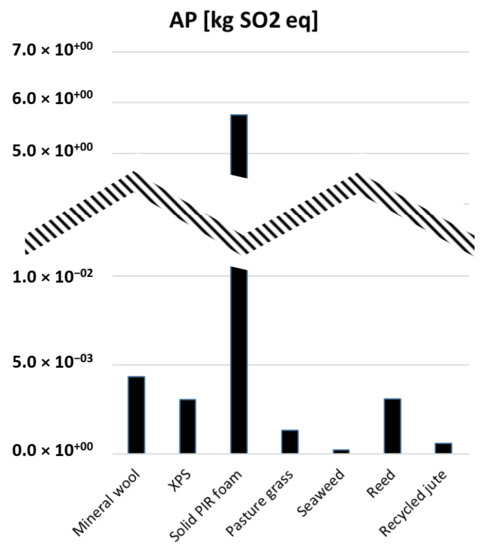
Figure 10.
Comparison of the AP of conventional and renewable insulation materials.
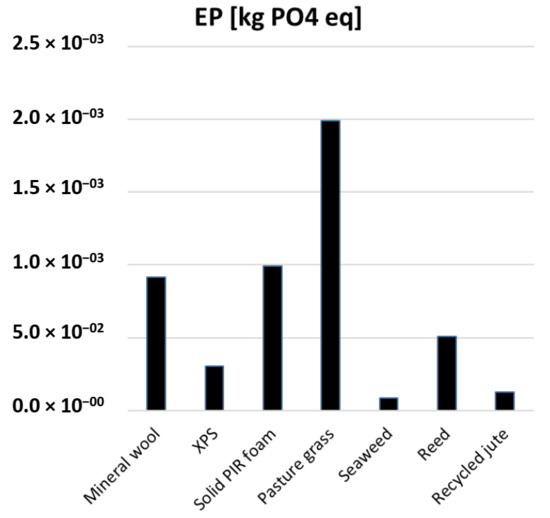
Figure 11.
Comparison of the EP of conventional and renewable insulation materials.

Figure 12.
Comparison of the POCP of conventional and renewable insulation materials.
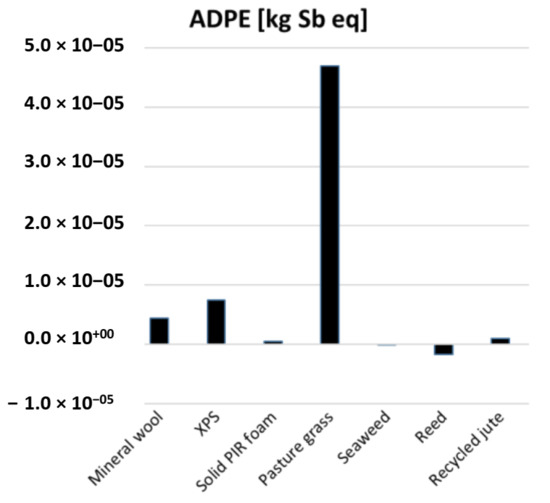
Figure 13.
Comparison of the ADPE of conventional and renewable insulation materials.
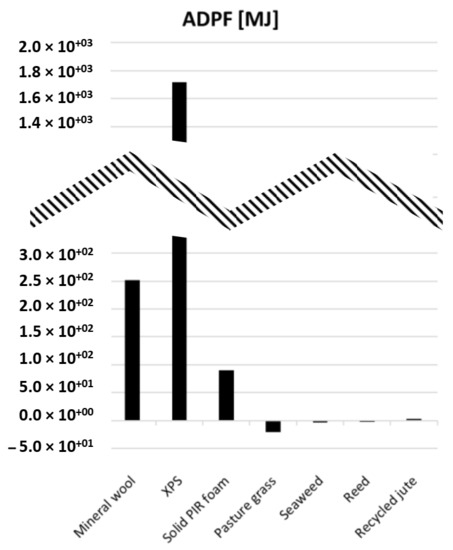
Figure 14.
Comparison of the ADPF of conventional and renewable insulation materials.
In comparison to conventional insulation materials, the analyzed materials from renewable feedstock generally show less impacts. Only for the impact categories EP and ADPE did the insulation material made from pasture grass, have higher insulation than the conventional counterparts.
The study is limited to the selected insulation materials and depends on the primary data collected which was performed at the production sites. All participating producers have received the recommendation to use the data collected to initiate a reviewed EPD certification to verify the results. A sensitivity analysis for the most contributory factors within the results was performed without the detection of relevant uncertainties. Further sensitivity analysis regarding the impact assessment methodology was not carried out, and this is recommended for further research. The given results from CML should be compared with other characterization models such as EF 3.0 [20]. A further limitation is the restriction of the LANCA® to terrestrial land use, excluding aquatic areas and biodiversity impact assessments.
5. Conclusions
In summary, it can be stated that all the assessed insulation materials showed significantly less environmental impacts than mineral or fossil-based insulation materials. Each production system was designed with the intention of giving an environmental advantage compared to the conventional systems or materials. With closed production loops (pasture grass insulation), the usage of waste or yet unused materials (seaweed and jute insulation), or extremely low treatment requirements (reed), the study materials have a huge potential as an environmentally friendly insulation alternative. This potential has been underlined and quantified within this study.
In future assessments, a consideration of the impacts on water use, aquatic area usage as an extension of the LANCA® approach to aquatic area and biodiversity would be of interest. Furthermore, since the assessed products are niche products, it would be valuable to perform a comparative approach for the possible replacement of a considerable market share of established products such as XPS, mineral wool, or PIR. With the immense environmental emissions originating from the building sector, eco-friendly alternatives for construction materials will gain in terms of market share as well as in public demand. Consequently, further inquiries into alternatives and increased awareness are vital tools to actively reduce emissions.
Author Contributions
Conceptualization, M.L. and A.G.; methodology, M.L. and A.G.; software, M.L. and A.G.; validation, M.L. and A.G.; data curation, M.L. and A.G.; formal analysis, M.L. and A.G.; supervision, M.L. and A.G.; writing—review and editing, M.L. and A.G.; investigation, A.T.; resources, A.T.; writing—original draft preparation, A.T.; visualization, A.T.; project administration, M.L.; quality assurance, S.A.; funding acquisition, S.A. All authors have read and agreed to the published version of the manuscript.
Funding
This research was funded by the “Fachagentur Nachwachsende Rohstoffe e.V.” (FNR), grant number 22006316.
Institutional Review Board Statement
Not applicable.
Informed Consent Statement
Not applicable.
Data Availability Statement
All supporting background data for the LCA analysis are the property of the Sphera GaBi Database and software.
Acknowledgments
The authors would like to thank all involved project colleagues from science and manufacturers for the fruitful exchange during the project, as well as Ulrike Bos for her preparatory work.
Conflicts of Interest
The authors declare no conflict of interest. The funders had no role in the design of the study; in the collection, analysis, or interpretation of data; in the writing of the manuscript; or in the decision to publish the results.
References
- Schlegl, F.; Gantner, J.; Traunspurger, R.; Albrecht, S.; Leistner, P. LCA of buildings in Germany: Proposal for a future benchmark based on existing databases. Energy Build. 2019, 194, 342–350. [Google Scholar] [CrossRef]
- Umweltbundesamt. Wärmedämmung—Fragen und Antworten: Hintergrund//März 2016. Available online: www.umweltbundesamt.de/publikationen/waermedaemmung (accessed on 27 April 2021).
- Asam, C. Dämmmaßnahmen an Gebäudefassaden: Eine Zusammenfassung derzeit aktueller Diskussionspunkte; Bundesinstitut für Bau- Stadt- und Raumforschung (BBSR) im Bundesamt für Bauwesen und Raumordnung (BBR): Bonn, Germany, 2017; ISBN 9783879941278. [Google Scholar]
- Fachagentur Nachwachsende Rohstoffe e.V. Absatzvolumen von Dämmstoffen in Deutschland 2019. Available online: https://mediathek.fnr.de/absatzvolumen-von-daemmstoffen-in-deutschland.html (accessed on 27 April 2021).
- Bundesministerium des Innern. ÖKOBAUDAT Database: Sustainable Construction Information Portal. Available online: https://www.oekobaudat.de/en.html (accessed on 27 April 2021).
- Deutsches Institut für Normung. DIN 4102-1:1998-05, Brandverhalten von Baustoffen und Bauteilen_-Teil_1: Baustoffe; Begriffe, Anforderungen und Prüfungen; Beuth Verlag GmbH: Berlin, Germany, 1998. [Google Scholar] [CrossRef]
- Deutsches Institut für Normung. DIN EN ISO 14040:2009-11, Umweltmanagement_- Ökobilanz_- Grundsätze und Rahmenbedingungen (ISO_14040:2006); Beuth Verlag GmbH: Berlin, Germany, 2009; Deutsche und Englische Fassung EN_ISO_14040:2006. [Google Scholar] [CrossRef]
- Deutsches Institut für Normung. DIN EN ISO 14044:2018-05, Umweltmanagement_- Ökobilanz_- Anforderungen und Anleitungen (ISO_14044:2006_+ Amd_1:2017); Beuth Verlag GmbH: Berlin, Germany, 2018; Deutsche Fassung EN_ISO_14044:2006_+ A1:2018. [Google Scholar] [CrossRef]
- Bruijn, H.; Duin, R.; Huijbregts, M.A.J.; Guinee, J.B.; Gorree, M.; Heijungs, R.; Huppes, G.; Kleijn, R.; Koning, A.; Oers, L.; et al. Handbook on Life Cycle Assessment: Operational Guide to the ISO Standards; Kluwer Academic Publishers: Dordrecht, The Netherlands, 2004; ISBN 9780306480553. [Google Scholar]
- Guinée, J.B.; Lindeijer, E. (Eds.) Handbook on Life Cycle Assessment: Operational Guide to the ISO Standards; Kluwer Academic Publishers: Dordrecht, The Netherlands, 2002; ISBN 1402005571. [Google Scholar]
- Leiden University. CML-IA Characterisation Factors. Available online: https://www.universiteitleiden.nl/en/research/research-output/science/cml-ia-characterisation-factors (accessed on 29 April 2021).
- Deutsches Institut für Normung. DIN EN 15804:2020-03, Nachhaltigkeit von Bauwerken_-Umweltproduktdeklarationen_-Grundregeln für die Produktkategorie Bauprodukte; Beuth Verlag GmbH: Berlin, Germany, 2014; Deutsche Fassung EN_15804:2012+A2:2019. [Google Scholar] [CrossRef]
- Bundesministerium des Innern. Leitfaden Nachhaltiges Bauen: Zukunftsfähiges Planen, Bauen und Betreiben von Gebäuden; Bundesministerium des Innern: Berlin, Germany, 2019. [Google Scholar]
- Sphera Solutions GmbH. GaBi Software-System and Database for the Life Cycle Engineering; Leinfelden-Echterdingen, Germany, 1992–2019. Available online: https://gabi.sphera.com/international/overview/what-is-gabi-software/ (accessed on 29 July 2021).
- Bos, U. Operationalisierung und Charakterisierung der Flächeninanspruchnahme im Rahmen der Ökobilanz; Fraunhofer Verlag: Stuttgart, Germany, 2019; ISBN 9783839614327. [Google Scholar]
- Bos, U.; Horn, R.; Beck, T.; Lindner, J.P.; Fischer, M. LANCA—Characterization Factors for Life Cycle Impact Assessment: Version 2.0; Fraunhofer Verlag: Stuttgart, Germany, 2016; ISBN 9783839609538. [Google Scholar]
- Beck, T. LANCA: Land Use Indicator Value Calculation in Life Cycle Assessment; Fraunhofer-Verlag: Stuttgart, Germany, 2010; ISBN 9783839601709. [Google Scholar]
- Sphera. GaBi Databases & Modeling Principles 2021. Available online: https://sphera.com/wp-content/uploads/2020/04/Modeling-Principles-GaBi-Databases-2021.pdf (accessed on 22 April 2021).
- Huijbregts, M.A.J.; Steinmann, Z.J.N.; Elshout, P.M.F.; Stam, G.; Verones, F.; Vieira, M.; Zijp, M.; Hollander, A.; van Zelm, R. ReCiPe2016: A harmonised life cycle impact assessment method at midpoint and endpoint level. Int. J Life Cycle Assess 2017, 22, 138–147. [Google Scholar] [CrossRef]
- Zampori, L.; Pant, R. (European commission), 2019: Suggestion for updating the Product Environmental Footprint (PEF) Method; Joint Research Centre, EUR 29682 EN, Publications Office of the European Union: Luxembourg, 2019; ISBN 978-92-76-00654-1. [Google Scholar] [CrossRef]
Publisher’s Note: MDPI stays neutral with regard to jurisdictional claims in published maps and institutional affiliations. |
© 2021 by the authors. Licensee MDPI, Basel, Switzerland. This article is an open access article distributed under the terms and conditions of the Creative Commons Attribution (CC BY) license (https://creativecommons.org/licenses/by/4.0/).